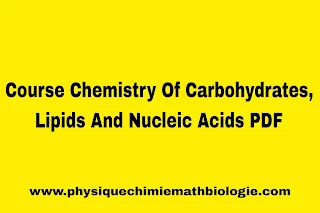Course Chemistry Of Carbohydrates, Lipids & Nucleic Acids PDF
1.Introduction:
The term ‘Carbohydrates’ describes a group of organic compounds, ranging from simple sugars through polysacchacharides, which form some of the important structures in the biosphere. Carbohydrates are the most abundant biomolecules on earth. Thus the term “carbohydrates” includes compounds such as simple sugars (glucose and galactose), storage carbohydrates (starch and glycogen )and complex carbohydrates (cellulose and a bacterial cell wall peptidoglycans). In this unit you are going to study carbohaydrates, their physical property, classification, functions and stereochemistry.
2.Objictives:
By the end of this units you are expected to know:
• What carbohydrates are;
• The various classification of carbohydrates;
• Physical property of carbohydrates;
• Different roles played by carbohydrates in living system;
• Stereochemistry of carbohydrates.
3. Definition of Carbohydrates:
Carbohydrates can be defined as polyhydroxy aldehydes or ketones, or as substance that yield one of these compounds on hydrolysis. Many but not all carbohydrates have the empirical formula (CH2O)n , where n is three (3) or greater than three. However, this formula does not fit in for all carbohydrates because some carbohydrates have been found to contain nitrogen, phosphorus or sulfur while some are deoxysugars eg deoxyribose.
The occurrence of the ratio of one molecule of water to one atom of carbon led to the name “hydrates of carbon” or “carbohydrates”. However this name is not applicable to all carbohydrates because of the aforementioned reason of the presence of nitrogen, phosphorus or sulfur.
3.1. Classification of Carbohydrates:
Carbohydrates are classified into (3) three major classes. These are: Monosaccharides, Oligosaccharides and Polysaccharides. The word “saccharide” is derived from the Greek word “sackaron” meaning sugar.
Monosaccharides are simple sugars consisting of single polyhydroxy aldelyde or ketone unit. The most abundant monosaccharide in nature is the six-carbon sugar D-glucose. Other monosaccharides include: Mannose, Galactose and Fructose.
Oligosaccharides consists of short chains of monosaccharide units or residues joined by characteristic linkage called glycosidic bonds. The most abundant ones are the diasaccharides which contain two monosaccharide units joined together by the glycosidic bond. Typical example is sucrose which consists of two six carbon sugars, D-glucose and D-fructose.
Polysaccharides are sugar polymers that occur in a continuous range of sizes, they usually contain more than 20 monosaccharide units. Polysaccharides may have hundreds and thousands of monosaccharides units joined together by glycosidic bonds.
3.2. Function/Role of Carbohydrates:
One of the primary role/function of carbohydrates is that they serve as nutrients to cells e.g glucose
• Carbohydrates also functions as form by which energy is stored in cells e.g. glycogen is the storage form of energy in animal cell while cellulose is the storage form of energy in plant cells.
• Carbohydrates function in serving as structural components of cells and tissue e.g chitin found in insects and cellulose found in plants.
• Carbohydrates like peptidoglycans serve as ‘ground substance’ in connective tissues ( a gelly-like material) that is very important to the proper functioning of the tissue).
• Carbohydrates e.g. Hyaluronic acid can also serve as lubricants due to their viscosity in joint.
• Carbohydrates e.g. Oligosaccharides serve as components of glycoprotein where they are involved cellular/molecular recognition.
• Carbohydrates e.g. Galactose and fucose also function as antigenic determinant of blood group (ABO) system.
• Carbohydrates, e.g. Sialic acid serve protecting roles, they shield oligosaccharides of glycoconjugates from the action of hydrolytic enzymes.
• Carbohydrates, e.g. glycolipids play role in infection in that they serve as site or recognition by toxins such as cholera toxins and pertusis toxin.
 |
| Course Chemistry Of Carbohydrates, Lipids & Nucleic Acids PDF |
